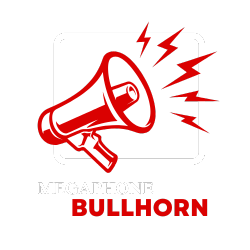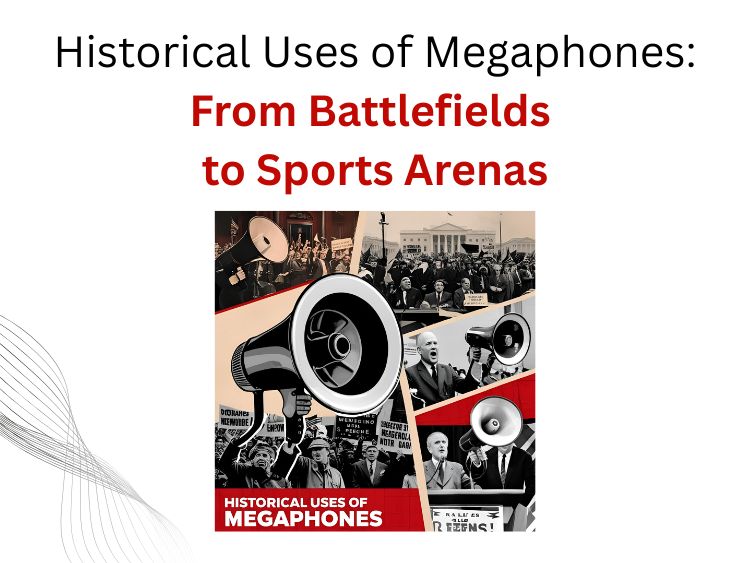Megaphones look like simple devices but they have played an important role in human communication across diverse sectors throughout history. Their primary purpose i.e amplifying and directing sound, has made them utmost important in society where the human voice alone cannot carry far enough. From ancient wars to today’s sports events, bullhorns have evolved and adapted to the needs of society. This blog explores the historical uses of bullhorns, tracing their invention and impact across centuries.
Ancient and Military Uses of Megaphones
The concept of sound amplification predates the invention of the modern bullhorn. In ancient times, leaders and military commanders had to communicate with large groups of people, especially on noisy battlefields. While there is limited archaeological proof of mechanical sound amplification in early times, ancient Greeks and Romans employed natural acoustics to have better vocal projection. Architectural structures, such as amphitheaters, were created to increase sound propagation. This could be considered an early attempt to address the limitations of human voice projection.
In the Middle Ages, military heads used horns and cones to command during battles. These initial megaphones were typically created from metal or wood, which could travel sound over longer distances. During naval engagements, speaking trumpets became particularly valuable for delivering orders across the expanse of large ships or among vessels. The increased use of such devices led to the development of more advanced sound projection devices in the future.
The Creation of the Modern Megaphone
The modern bullhorn began to shape in the 17th century with the study of polymath Athanasius Kircher. Kircher, a scholar, experimented with sound amplification through large, conical shaped devices. In 1650, he published his work on “speaking tubes,” which could transmit sound across significant distances. However, it was not unless the megaphone of today was created in the 19th century.
Thomas Edison is known for refining the modern bullhorn in the late 19th century. His modifications developed in the 1870s for public speaking and theatrical performances. Edison’s bullhorn could amplify sound without electrical power, making it a revolutionary tool for communication. This invention had vital implications for various public arenas, including political rallies, religious gatherings, and functions.
Megaphones in Civil and Political Contexts
Throughout the 20th century, bullhorns became a common tool at public demonstrations, political campaigns, and civil rights movements. Their portability and ease of use made them best for amplifying the voices of leaders addressing large crowds. During the Civil Rights Movement in the United States, megaphones were used to deliver the speeches of influential figures like Dr. Martin Luther King Jr. This use of megaphones enabled messages of equality and justice to reach out to the broader audiences and bring social change.
Bullhorns also played a necessary role during wartime. In World War II, they were used on the frontlines to give commands, disseminate propaganda, and bring coordination between soldiers. Air raid wardens and civil defense workers depended on bullhorns to announce emergency instructions to civilians during bombing raids. The ability to convey clear and immediate messages through bullhorns helped save lives in high-risk situations.
Megaphones in Sports and Entertainment
As sporting events grew in popularity during the 20th century, bullhorns became indispensable tools for coaches, referees, and cheerleaders. Before the electronic sound systems, cheerleaders generally used handheld megaphones to lead chants and hype up crowds. In stadiums and large arenas, bullhorns allowed officials to communicate with both participants and viewers. Announcers used them to comment and maintain rules during events. The bullhorn’s capacity to project sound across expansive venues made it an essential tool in ensuring smooth operations at public gatherings.
Beyond sports, megaphones found a place in the entertainment industry. Directors on film sets used megaphones to give instructions to large casts and crews. Similarly, amusement park operators and parade organizers used megaphones to manage crowds and give guidance. The versatility of megaphones in such diverse entertainment contexts highlights their enduring value in facilitating mass communication.
The Transition to Electronic Amplification
The introduction of electronic amplification in the middle of the 20th century marked a turning point in the evolution of bullhorns. Powered bullhorns, combined the traditional conical shape with electrical components, significantly improving their sound transmission. This technological advancement expanded the range and clarity of amplified speech, making powered megaphones important for outdoor events and large-scale communication efforts.
Powered amplification became a standard tool for emergency services, including police and fire departments. Their projecting authoritatively and intelligible commands proved invaluable during crises and disaster responses. Law enforcement agencies also adopted bullhorns for crowd control and public safety announcements. You can choose your megaphones from brands like 5 Core, MyMealivos, Pyle etc.
Conclusion
From their early use on battlefields to their continued use in sports arenas, megaphones have a long and storied history as devices of communication. Their evolution from simple acoustic devices to sophisticated electronic tools shows humanity’s enduring need to project voices across distances. Whether amplifying the commands of military leaders, the chants of cheerleaders, or the protests for social justice, megaphones have consistently played a crucial role in shaping public discourse. As technology progresses, the megaphone represents a powerful symbol of amplified voices and the influential human urge to be heard.




